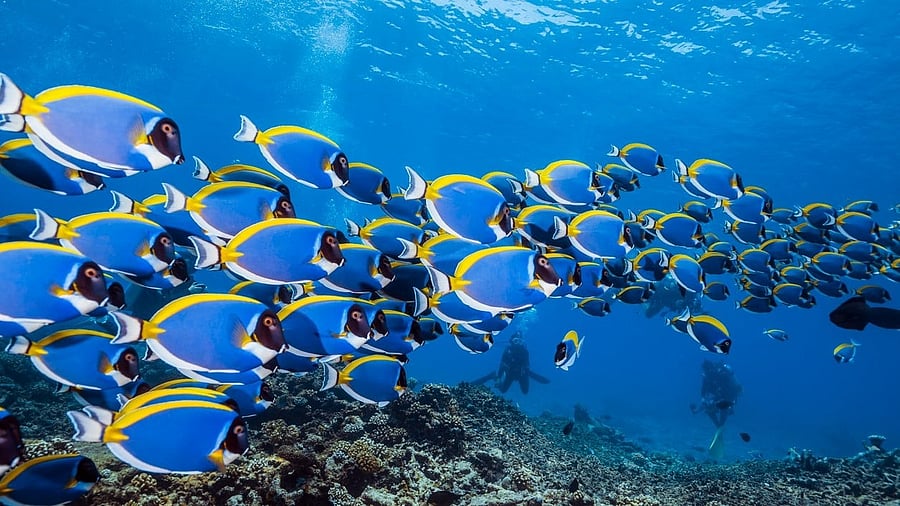
Image showing marine life. For representational purposes.
Credit: iStock Photo
The high seas refer to areas of the oceans that lie beyond national jurisdiction or beyond 200 nautical miles (370 km) from any country's exclusive economic zones (EEZs). These vast expanses cover over 50% of the planet’s surface and roughly two-thirds of the ocean's area.
Oceans provide a wide range of ecosystem services—provisioning, regulating, supporting, and cultural—that are vital to planetary health and human well-being. Apart from fish stocks, they offer minerals such as oil, petroleum, and chemical compounds used in the pharmaceutical industry; renewable energy sources like wave and tidal energy; and essential transport routes.
According to the World Ocean Review, the estimated annual landed value of fish globally is around $90 billion. About 600 million people worldwide depend on fisheries and aquaculture for their livelihoods. The Food and Agriculture Organisation (FAO) reported that in 2022, about 61.8 million people were directly employed in the primary sector of fisheries and aquaculture—a number that would rise significantly when including those in processing and marketing. Fish and seafood provide over 2.9 billion people with 20% of their animal protein needs.
Shipping generates vast revenues. In 2022, the global parcel shipping revenues were estimated at $485 billion. In 2024, earnings before interest and tax from container shipping reached $27.3 billion. The global coastal and maritime tourism market, including beach tourism, cruise tourism, and other coastal recreational activities, was valued at over $3 trillion in 2024 and is projected to rise to nearly $5 trillion by 2030.
Beyond being a major carbon sink, oceans play a critical role in climate regulation and nutrient cycling. They produce between 50% and 85% of the earth’s atmospheric oxygen and are home to over 242,000 known marine species, with approximately 2,332 new species discovered annually.
However, the oceans face mounting threats from climate change, pollution, and unsustainable exploitation. Rising carbon emissions are causing ocean acidification, which disrupts marine species and food chains. Sea level rise, driven by global warming, threatens the lives and livelihoods of coastal communities and cities vulnerable to flooding.
Pollution is another major threat. An estimated 11 million tonnes of plastic enter the ocean each year. Between 2000 and 2019, around 30 Mt accumulated in marine environments. Experts warn that by 2050, there may be more plastic in the oceans than fish. Marine plastic kills an estimated 100,000 marine mammals—such as whales, dolphins, seals, and turtles—and about one million seabirds annually. Despite the urgency, the global plastics treaty has yet to be agreed upon, with resistance from oil and polymer-producing countries unwilling to curb plastic production. Oil spills, like the recent incident off the coast of Kerala, threaten marine life and the livelihoods of coastal communities.
Although oceans are a global commons, they are treated as an open-access resource. leaving them vulnerable to overexploitation. Industrial fishing practices are exacerbating marine pollution and pushing some species towards extinction. The International Union of Conservation Nature (IUCN) estimates that around 1,616 fish species—including sharks, rays, and bluefin tuna—are endangered due to overfishing. According to the Worldwide Fund (WWF) for Nature, the global abundance of sharks and rays has declined by about 71% over the past 50 years.
To further the UN Sustainable Development Goal (SDG) 14, ‘Life Below Water,’ the UN in 2023 launched a legally binding international treaty under the United Nations Convention on the Law of the Sea (UNCLOS) to conserve and sustainably manage marine biodiversity in areas beyond national jurisdiction—the BBNJ Agreement, or High Seas Treaty. The treaty aims to ensure the sustainable use and management of marine genetic resources, fair and equitable benefit-sharing, the establishment of marine protected areas, environmental impact assessments, capacity building, and the sharing of marine technology.
As of June 2025, 136 countries have signed the treaty, but only 50 have ratified it—10 short of the 60 required for it to come into force. Even if this threshold is met, the absence of ratification by major maritime powers threatens its implementation.
The UN estimates that effective marine protection would require at least $175 billion annually. Yet, SDG 14 received just $10 billion in funding over five years (2015-2019)—less than 0.01% of all global sustainable development funding. A high-level UN Panel on ocean economies notes that the funding gap comes at a considerable cost, hindering progress on marine conservation, fisheries reforms, and the blue economy, where every $1 invested is estimated to yield $5 in global benefits by 2050.
While conservation funding for fisheries is limited, subsidies that promote overfishing exceed $35.4 billion annually. The world’s largest fishing subsidisers are China ($7.3 billion), the EU ($3.8 billion), the US ($3.4 billion), South Korea ($2.6 billion), and Japan ($2.4 billion). If these environmentally harmful subsidies could be repurposed, it could help incentivise and promote sustainable use and management of oceanic resources and realise the goals of the High Seas Treaty.
Given that the rich nations have failed to meet the funding gaps required to further the Paris Agreement and Kunming-Montreal Global Biodiversity Framework, the prospects for realising the goals of the High Seas Treaty are not bright.
(The writer is Lead Author, GEO-7, United Nations Environment Programme, Nairobi)